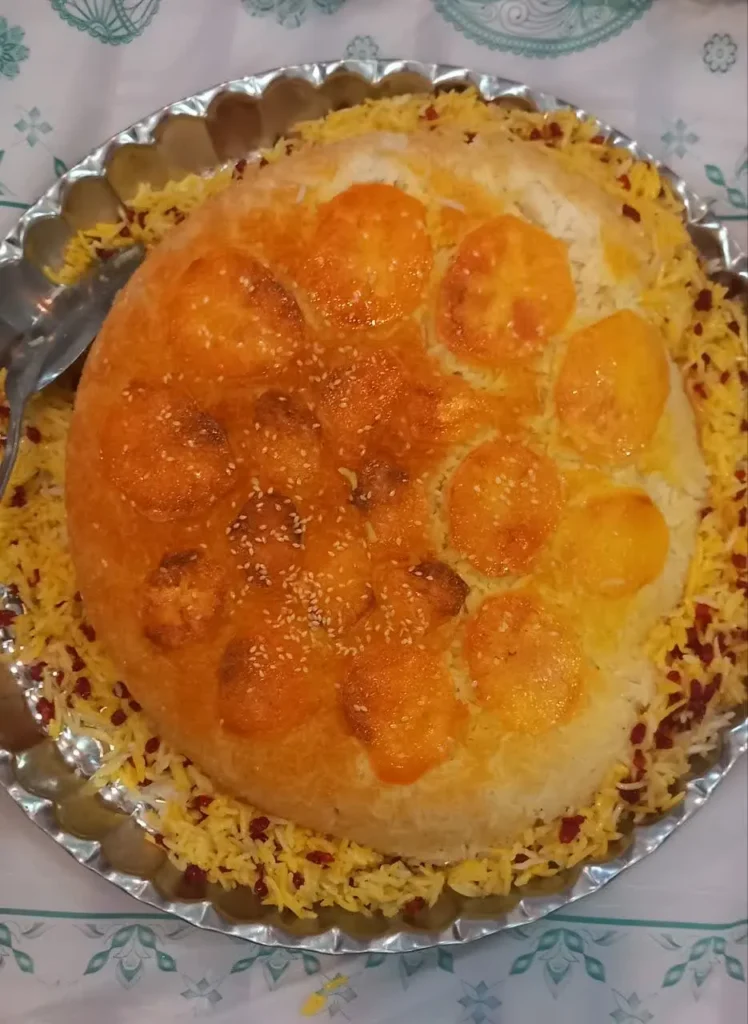Mastering the Art of Tahdig: The Golden Crust That Elevates Every Persian Meal

If you’ve ever dined on Persian cuisine, chances are you’ve encountered one of its most beloved treasures: Tahdig. This crispy, golden crust that forms at the bottom of the pot is often the most anticipated part of the meal. Whether it’s made with rice, potatoes, lavash bread, or even macaroni, tahdig is the flavorful, crunchy highlight that showcases the cook’s skill and creativity.
In this article, we’ll explore everything you need to know about tahdig: what it is, how to make it with different ingredients, and tips for achieving that perfect, irresistible crunch every time.
🍚 What Is Tahdig?
In Farsi, tahdig literally means “bottom of the pot”. It refers to the crispy, browned layer that forms during the cooking of rice or other starches. Far from being an accident, tahdig is a culinary goal in Persian cooking. While traditionally associated with rice, creative home cooks and chefs have developed many delicious versions using bread, sliced potatoes, or even spaghetti or pasta.
🔄 Types of Tahdig
Here’s a breakdown of popular types of tahdig and how each one offers a unique texture and flavor:
1. Rice Tahdig
The most traditional form. After parboiling and draining the rice, it’s layered back into a non-stick or cast-iron pot with oil and sometimes saffron. A layer at the bottom is pressed down to form a crispy golden crust.
Flavor & Texture: Buttery, slightly nutty, and pure rice flavor.
2. Potato Tahdig (Tahdig-e Sibzamini)
Sliced raw potatoes (often peeled and cut into ¼-inch rounds) are arranged in oil at the bottom of the pot before adding the rice. The potatoes crisp up beautifully.
Flavor & Texture: Crunchy edges with a tender center and rich, earthy flavor.
3. Bread Tahdig (Tahdig-e Nan)
Flatbreads like lavash, barbari, or tortilla are used as a base. They’re pressed into the oil and create an ultra-crunchy, flavorful crust.
Flavor & Texture: Crispy like chips; perfect with stews and rice.
4. Pasta Tahdig (Macaroni Tahdig)
In Iranian-style makaroni, the pasta is layered in a pot in a similar method to rice, forming a browned crust that’s rich and flavorful.
Flavor & Texture: Crispy, oily, and savory — reminiscent of toasted pasta.
🍳 How to Make Perfect Tahdig
While the ingredients vary, the method remains largely the same: controlled heat, enough oil, and patience.
🔹 Basic Tahdig Method (For All Variations)
Prepare the starch (parboil rice/pasta, or slice raw potatoes).
Heat oil generously in a non-stick or heavy-bottomed pot.
Layer the tahdig base: bread, potatoes, rice, or pasta.
Add the rest of your rice or pasta, pile it into a pyramid shape for better airflow.
Cover the lid with a kitchen towel or paper towel to catch moisture.
Steam on low heat for 45 minutes to 1 hour, until the bottom is golden brown and crisp.
Invert onto a platter to reveal the crispy crust.
🧂 Tips & Tricks for Tahdig Success
Use Enough Oil: Don’t skimp on oil; it’s crucial for crisping.
Low & Slow: Rushing with high heat will burn the bottom. Use medium-low heat and be patient.
Non-Stick Is Your Friend: For beginners, non-stick pots make releasing the crust much easier.
Saffron Magic: A splash of saffron water adds color and aroma to rice tahdig.
Check with a Spatula: Gently lift one edge to see if the crust is done.
🍽 Serving & Pairing
Tahdig is best served warm, ideally immediately after inverting. It’s often presented atop the rice or on a separate plate for dramatic flair. It pairs perfectly with:
Khoreshts (Persian stews) like Ghormeh Sabzi or Fesenjan
Grilled meats like kebab
Yogurt dips, pickled vegetables, or fresh herbs
🧑🍳 Regional & Creative Variations
Persian cooks are incredibly inventive. Here are some less common but equally delicious tahdig variations:
Tahdig-e Tahchin: From saffron yogurt rice pie, with tahdig built into a baked rice cake.
Tahdig with Carrots or Eggplants: For a vegetarian-friendly, flavorful twist.
Herb Tahdig: Chopped dill or parsley added to the rice layer for aroma.

❓Frequently Asked Questions
Q: Why does my tahdig stick to the pot?
A: Either not enough oil was used or the pot wasn’t non-stick. Let it cook longer before inverting.
Q: Can I reheat tahdig?
A: Yes, re-crisp in a hot pan or air fryer. Avoid microwaving as it will turn soggy.
Q: Is tahdig always crunchy?
A: Ideally, yes. But softer variations like potato tahdig have crispy edges and a softer center.
💡 Final Thoughts
Tahdig is more than just the crispy part of a meal — it’s a culinary celebration. From its golden appearance to its satisfying crunch, tahdig transforms simple rice or pasta into a textural experience. Whether you use bread, potatoes, or macaroni, you can create a masterpiece that elevates your meal to another level.
If you’ve never made it before, start simple with bread tahdig, then work your way to potatoes or rice. With practice and patience, you’ll master the golden art of tahdig — and your guests will never stop asking for it.

